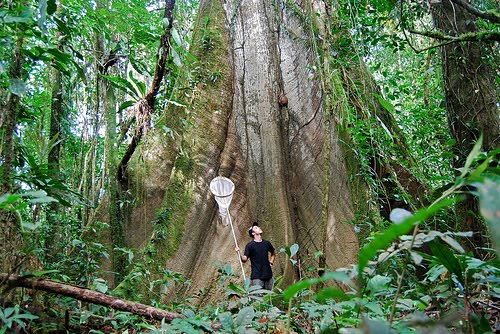A bit over three weeks into my stay here at La Selva, I’m sad to report that I’m not having much luck finding my butterflies. Although many of the same species occur here as at my other sites in Ecuador and Panama, they are not visiting my traps as frequently as in those places. I’ve only collected about 6 species in total, and although they are all things that I would expect to find, 5 of the 6 are represented by a single individual (the other, Zaretis itys, is actually quite abundant). Thinking that perhaps the butterflies here might have a different bait preference (I typically use rotting fish, whereas most people working with butterflies in Costa Rica use rotten or over-ripe fruits), I began to experiment with a mixture of old bananas and sugar – but still, almost no butterflies. While this is, in itself, an interesting phenomenon, it makes the difficult, dirty work in the field feel decidedly futile, and the situation is overall quite discouraging. I think that abundance is generally just lower here than in other places – for example, in Ecuador one regularly sees butterflies in my target groups patrolling forest edges and light gaps, something I have rarely witnessed here so far. The weather is almost certainly a factor, as it has rained almost every day since my arrival, and butterflies generally do not fly without at least some sun. Some folks here have also suggested that pesticides might be a factor – the area surrounding the station is heavily planted with banana and pineapple, which are both heavily sprayed with pesticides. While I personally doubt it is very important, especially considering all the other insects that I typically expect in my traps, including many flies and beetles, are extremely abundant, there is a possibility that pesticides are drifting over from adjacent fields and affecting butterflies. Whatever the cause, it is making for a very frustrating time.
 |
| An Adelpha butterfly, one that I would expect to find in my traps. |
 |
| Another of my guys - this one is Opsiphanes. |
On a brighter note, my cutaneous larva migrans has grown by leaps and bounds! It started just on the upper side of my left hand, and has now spread around to my palm and to two spots on my chest and left shoulder. And all this after taking two different nematicides! I’m thinking it’s time for medication round two… for now, maybe I can at least spin this as a Halloween costume?? I just need to return from the field and I’m dirty, smelly, parasite-ridden field biologist man!
 |
| It grows!! And itches like mad! |




No comments:
Post a Comment